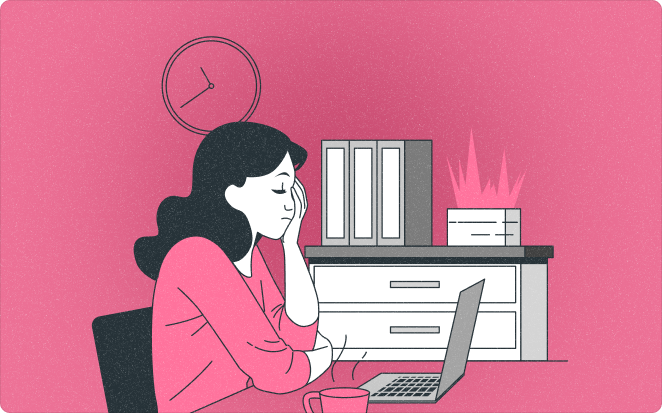How to Avoid Working Overload on Your Team?

Work overload is a common issue that many teams encounter in the workplace. It can have detrimental effects on both the well-being of employees and the overall productivity and performance of the team. Understanding what work overload is and how to avoid it is crucial for maintaining a healthy and efficient work environment.
Work overload refers to the situation in which an individual or a team is overwhelmed with an excessive amount of work or tasks that surpass their capacity to handle within a given timeframe. This overload can arise from various causes, such as unrealistic deadlines, inadequate resources, poor workload distribution, or an increase in workload without additional support.
The impact of work overload on your team can be significant. It can lead to negative consequences on employee well-being, including increased stress levels, burnout, and decreased job satisfaction. Furthermore, it can have detrimental effects on productivity and performance, as overwhelmed employees may struggle to meet deadlines, make errors, or experience reduced concentration and focus.
Recognizing the signs and symptoms of work overload is essential for early intervention. Physical symptoms may include fatigue, headaches, or sleep disturbances, while emotional and mental symptoms may manifest as increased irritability, anxiety, or feelings of overwhelm.
To avoid work overload and promote a healthier work environment, several strategies can be implemented. Proper workload distribution ensures that responsibilities are allocated fairly and are manageable for each team member. Effective time management techniques, such as setting realistic deadlines and prioritizing tasks, can help prevent work overload. Promoting work-life balance and encouraging open communication and collaboration within the team are also vital in reducing the likelihood of work overload occurring.
By understanding work overload and implementing preventive measures, organizations can create a positive and productive work environment that supports the well-being and success of their teams.
Key takeaways:

Understanding Work Overload
Understanding work overload is essential to prevent its negative impact on individuals. Work overload occurs when an individual is assigned more work than they can handle in a given time period, leading to stress, burnout, and decreased productivity. To comprehend this phenomenon, several factors need to be considered.
Firstly, workload distribution plays a crucial role. Assigning an equitable amount of tasks to employees ensures that no one feels overwhelmed. Deadlines also need to be taken into account, as unrealistic or conflicting time constraints can contribute to work overload. Additionally, the availability of resources is another factor to consider. Adequate tools, materials, and support are essential to effectively manage workload and prevent overload.
Furthermore, employee skills and experience should be considered when assigning tasks. Matching the requirements of the job to the abilities of the individual can alleviate work overload. Finally, individual capacity must also be taken into consideration. Each person has unique limitations and limitations, and expecting them to surpass their capabilities will only lead to negative outcomes.
By comprehensively understanding work overload and considering factors such as workload distribution, deadlines, resources available, employee skills, experience, and individual capacity, organizations can promote a healthier work environment and enhance overall productivity.
Get more out of your business
Get the best employee engagement content every week via mailing list

What is Work Overload?
What is Work Overload? Work overload refers to an excessive amount of work that surpasses a person’s capacity to handle effectively. It can lead to burnout, decreased productivity, and negative impacts on mental and physical health. Example – In the early 20th century, the Industrial Revolution caused work overload for many factory workers due to long hours and demanding work conditions.
Causes of Work Overload
Some causes of work overload, also known as work overwhelm, can stem from a variety of factors. One major cause is the presence of unrealistic deadlines, which put immense pressure on employees to meet high expectations in a limited amount of time. Additionally, an excessive workload, where individuals are burdened with an abundance of tasks and responsibilities, can contribute to work overload.
Another factor that contributes to work overload is a lack of delegation. When tasks are not distributed evenly among team members or when managers fail to delegate effectively, individuals often find themselves overwhelmed with a heavy workload. This lack of delegation also prevents employees from developing new skills and can lead to burnout.
Poor task management is another cause of work overload. When individuals struggle to prioritize tasks, organize their time efficiently, or navigate competing deadlines, they can easily become overwhelmed.
Unexpected emergencies can also contribute to work overload. When unforeseen issues arise that require immediate attention, individuals may find themselves having to juggle additional responsibilities on top of their already full workload.
Other causes of work overload include understaffing, where teams are operating with a limited number of personnel, and inefficient processes, where outdated or cumbersome procedures slow down productivity. Frequent interruptions, such as constant meetings, phone calls, or emails, can disrupt workflow and contribute to work overload. Additionally, a lack of work-life balance, where individuals are unable to disconnect from work obligations during personal time, can result in the constant feeling of being overwhelmed.
It is important to recognize these causes of work overload, as they can have detrimental effects on team members’ well-being and productivity. By addressing these factors and implementing strategies to manage workload more effectively, organizations can create a healthier and more efficient work environment.

The Impact of Work Overload on Your Team
Work overload, a common phenomenon in today’s fast-paced work environment, has a profound impact on your team. In this section, we’ll uncover the repercussions of work overload on your team’s well-being and productivity. Brace yourself as we delve into the detrimental effects it can have on employee well-being, and discover how it takes a toll on productivity and performance. Get ready to gain valuable insights into the hidden consequences of work overload and explore strategies to mitigate its damaging influence.
Effects on Employee Well-being
Work overload can have detrimental effects on employee well-being, affecting their overall health and happiness. It can lead to increased stress, exhaustion, and burnout, resulting in physical symptoms such as headaches and muscle tension. Moreover, the emotional and mental well-being of employees can be negatively impacted, leading to anxiety and depression. To ensure the well-being of employees and mitigate the effects of work overload, it is crucial to distribute workloads fairly, effectively manage time, set realistic goals, encourage a healthy work-life balance, and foster open communication and collaboration within the team.
Effects on Productivity and Performance
- Work overload can have negative effects on productivity and performance as employees may struggle to prioritize tasks and manage their time effectively.
- When employees are overloaded with tasks, they may rush through their work or make mistakes, resulting in a lower quality of work.
- Excessive workloads can lead to burnout, resulting in exhaustion, physical and mental health issues, and a decrease in motivation and job satisfaction.
- Work overload can significantly increase stress levels among employees, which can adversely impact their ability to focus, problem-solve, and make sound decisions.
- When employees consistently experience work overload, they may become dissatisfied with their job and seek opportunities elsewhere, leading to higher turnover rates.

Signs and Symptoms of Work Overload
Feeling overwhelmed and drained at work? Let’s dive into the signs and symptoms of work overload, so you can identify if you’re pushing the limits. From physical warning signs to emotional and mental struggles, we’ll explore the toll work overload can take on your well-being. Get ready to uncover the red flags and gain a deeper understanding of how work overload may be impacting you and your team.
Physical Symptoms
Signs of work overload can manifest physically, such as physical symptoms like fatigue, headaches, and muscle tension. These physical symptoms are your body’s way of signaling that it is overwhelmed and stressed. It’s important to recognize these physical signs and take steps to address them, such as incorporating regular breaks and exercise into your routine to reduce the impact of work overload.
In 1880, Dr. George Beard coined the term “neurasthenia” to describe the physical symptoms of work overload, which he observed among professionals during the Industrial Revolution. Symptoms included exhaustion, headaches, and digestive issues. This historical example highlights the long-standing recognition of the physical toll that work overload can have on individuals.
Emotional and Mental Symptoms
- Increased stress and anxiety levels
- Feeling overwhelmed and unable to cope
- Irritability and mood swings
- Difficulty concentrating and making decisions
- Insomnia or changes in sleep patterns
A colleague of mine, Sarah, experienced emotional and mental symptoms due to work overload. She became increasingly irritable and struggled to focus on her tasks. Sarah started having trouble sleeping and felt constantly overwhelmed. It was only after implementing better workload management and seeking support from her team that she was able to regain her emotional well-being.

How to Avoid Work Overload on Your Team
Tired of feeling overwhelmed with work? In this section, we’ll uncover powerful strategies to avoid work overload on your team. From proper workload distribution to effective time management, setting realistic goals and priorities, promoting work-life balance, and fostering open communication and collaboration, we’ll explore practical techniques for keeping your team productive and stress-free. So, let’s dive in and discover how to create a harmonious and efficient work environment without the burden of overload.
Emotional and Mental Symptoms
- Ensure proper workload distribution by assessing the workload and prioritizing tasks based on urgency and importance.
- Delegate tasks to team members based on their strengths and workload capacity to maintain proper workload distribution.
- Regularly review and adjust workload distribution to ensure a fair balance and proper workload distribution.
- Provide necessary resources and support to help team members successfully complete their assigned tasks and maintain proper workload distribution.
- Encourage open communication and collaboration to ensure transparency, effective coordination, and proper workload distribution.
Effective Time Management
Setting Realistic Goals and Priorities
To avoid work overload on your team, it is crucial to set realistic goals and priorities. Here are some steps to naturally incorporate these keywords:
Promoting Work-Life Balance
To effectively promote work-life balance and prevent work overload, it is crucial to prioritize the well-being of your team.
- One way to achieve this is by encouraging flexible work arrangements, such as remote work or flexible schedules, which can contribute to a better work-life balance.
- Additionally, it is important to promote regular breaks and urge employees to disconnect from work during non-working hours. This allows them to recharge and maintain a healthy work-life balance.
- Supporting wellness initiatives is another valuable approach. This can involve providing access to fitness facilities or implementing mindfulness or stress management programs, which will positively impact work-life balance.
- As a leader, it is essential to lead by example and prioritize work-life balance in your own actions and behaviors. Demonstrating that you value work-life balance will encourage your team to do the same.
- Furthermore, open communication with your team about the significance of work-life balance is essential. Encourage them to prioritize their personal lives outside of work, recognizing that it is vital for their overall well-being.
Promoting work-life balance not only benefits the well-being of your team but also leads to higher productivity and overall job satisfaction.
Open Communication and Collaboration
Open communication and collaboration are vital strategies for avoiding work overload and cultivating a productive and healthy team environment.
- Promote regular team meetings to foster discussion about workload, challenges, and opportunities.
- Encourage transparency and the sharing of information to ensure that everyone comprehends their tasks and responsibilities.
- Create open channels for feedback and suggestions to address potential issues and enhance workflow.
- Nurture a culture of collaboration that stimulates teamwork, cooperation, and knowledge-sharing.


